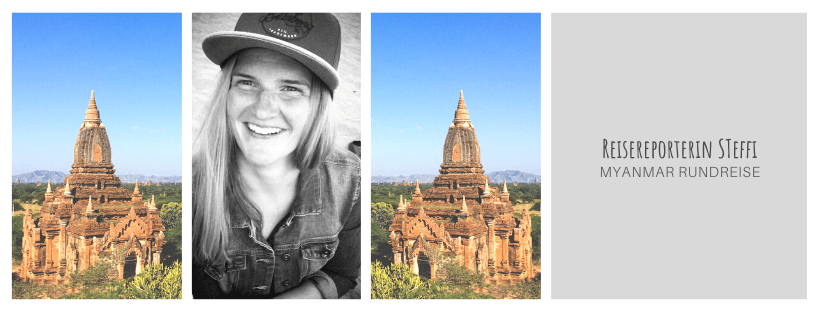Today the journey takes us to Asia, more specifically to Myanmar. Steffi had a wonderful Myanmar tour and shares her experiences, highlights, and moments in the land of a thousand pagodas in today’s travel report. From Yangon, we went to Inle Lake, to the floating villages, the one-legged rowers, to Mandalay, and on to the royal city of Amarapura, the U Bein Bridge, and Bagan. We hope you enjoy reading and following along! A big thank you, dear Steffi, for this wonderful Myanmar guide! It makes you feel homesick straight away!
You might also be interested in these reports:
- Journey through the Atacama Desert
- The most beautiful highlights in Tasmania
- Alaska round trip & Highlights
- Round trip through North Macedonia
- Tonga in the South Pacific
- Cool round trip Cornwall and Devon
- My beautiful Maldives trip
- On your own through Botswana
- The Indonesian Moluccas
- Top Highlights on Nusa Penida
- These reports might also interest you:
- Off to Myanmar
- Arrival in Myanmar
- Travel planning
- Route and sights
- Stop 1: Yangon
- Stop 2: Inle Lake
- Stop 3: Mandalay
- Stop 4: Bagan
- Safety in Myanmar
- Duration of the tour
- Costs and prices
- Food and drink
- 3 important things to pack
- Further information & Tips
Off to Myanmar
I first became aware of Myanmar in a well-known Swedish furniture store. There was a picture of the historic royal city of Bagan. It was the one in which hot air balloons rose over pagodas at sunrise. And I wanted to experience that sunrise for myself.
Since its political liberalization in 2011/2012, Myanmar (also known as Burma) has become increasingly attractive to individual travelers. Previously, travelers could only explore the country on guided group tours. The special appeal lay in exploring a country that is perhaps not yet “overrun” by tourists, such as Thailand or many corners of Indonesia.

After some research on Myanmar, it became clear to me that, in addition to Bagan, I also wanted to experience Inle Lake and the cities of Mandalay and Yangon. The capital, Naypyidaw, is merely an administrative center and offers few exciting sights. I was in Myanmar for two weeks in November/December 2017.
Prior to my trip, the military’s harsh and inhumane actions against the Rohingya minority became public in the German media. I thought long and hard about whether to undertake this trip or visit another country. Since the military’s actions in no way reflect the mindset of the population, and I wanted to get to know the people and culture, I ultimately decided on Myanmar.
Getting to Myanmar
There are no direct flights from Germany to Myanmar. Flights usually go via Bangkok, Singapore, Dubai, Doha, or via Vietnam (Saigon or Hanoi). My own flight went from Frankfurt via Saigon to Yangon. On the return journey, I flew from Yangon via Hanoi to Frankfurt. The flight time alone is around 16 hours. The two international airports are in Yangon (also called Rangoon) and Mandalay; there are also 16 local airports.
Unfortunately, the onward journey from Yangon Airport to the city center was somewhat more difficult in 2017, as there was no public bus service to the airport. Given the choice between an expensive shuttle bus, a bus stop about 5 km away with no fixed departure schedule, and the train station about 3 km away, I opted for the latter option. A ride on Yangon’s train is an experience in itself.
Update: Since November 2018, there has apparently been a public bus service between Yangon Airport and the city center. For 500 MMK (approximately €0.30), the bus travels towards Yangon Central Station, past the Shwedagon Pagoda and the Sule Pagoda. Travel forums indicate that bus drivers do not give change. So if you’re exchanging money at the airport, you should ask for 500 MMK notes. Departure times depend on the time of day and traffic conditions in Yangon. The journey can take between 30 and 50 minutes.
Travel Planning
I planned my trip myself. Before a trip, I pick out highlights. I look at forums, travel blogs, and travel guides to see what’s recommended for the country. For Myanmar, this resulted in four places I wanted to visit to see the local sights:
- Yangon
- Inle Lake
- Mandalay
- Bagan
Once I’ve decided on my route, I start researching how to get between the locations. I use the website www.rome2rio.com to compare prices for buses, trains, and, if necessary, domestic flights. I generally travel on a low budget, so I’m always looking for good prices.
In Myanmar, I therefore traveled a lot by bus and train. I usually book accommodations through www.booking.com*. As a solo traveler, I prefer shared rooms. This is partly for financial reasons, but I’ve also found that shared rooms allow me to quickly connect with other travelers.
Route and Sights
The tour began; I was finally in the land of a thousand pagodas. In the following chapter, I’ll tell you about my stops, highlights, sights, and excursions. I started in Yangon, then continued on to Inle Lake, Mandalay, and Bagan. My trip ended in Yangon.
Stop 1: Yangon
Yangon is the largest city in the country and my starting and ending point for this Myanmar tour. In Yangon, you’ll find British colonial houses, modern skyscrapers, and gilded pagodas, which attract thousands of pilgrims every year. From the airport, I walked to the nearest train station and then took the Circle Train to the main station in Yangon. From there, it was about a 15-minute walk to the Sule Pagoda. My accommodation, the Dengba Hostel (1 night in a dorm, about €10), was nearby.
Sights and Highlights in Yangon
One of my highlights in Yangon was a visit to the Shwedagon Pagoda. It is the most important sacred building in Myanmar and also its most important religious center. Entrance costs around $8; it’s best to bring a long scarf or skirt to cover your knees and legs. If necessary, you can also rent one at the entrance for an additional fee.
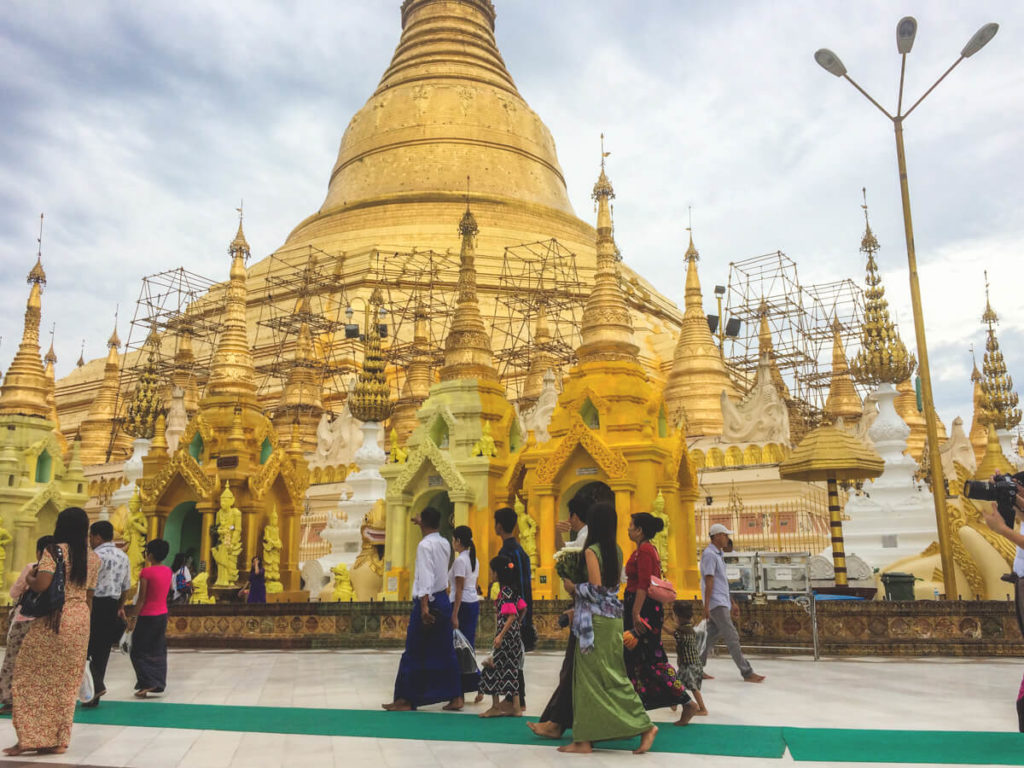
Next, we head to the Sule Pagoda. Entrance costs about $2. It’s best to stop before you reach the Shwedagon Pagoda, otherwise you might be disappointed by the much smaller pagoda. The many small shops around the pagoda are particularly attractive. Furthermore, the pagoda is located in the middle of a roundabout, and the Southeast Asian traffic is legendary. The journey to the pagoda is adventure enough.

The walk around Kandawgyi Lake is very worthwhile. On the east side is the Karaweik Palace, a modern Burmese restaurant with various performances. Unfortunately, I didn’t go inside, but the restaurant resembles a boat and offers great photo opportunities from all sides of the lake. On the southwest side of the lake is a wooden bridge. Presumably none of the wooden slats are still intact, but the bridge still appears solid. For a break from the hectic city, a detour to the lake is worthwhile.
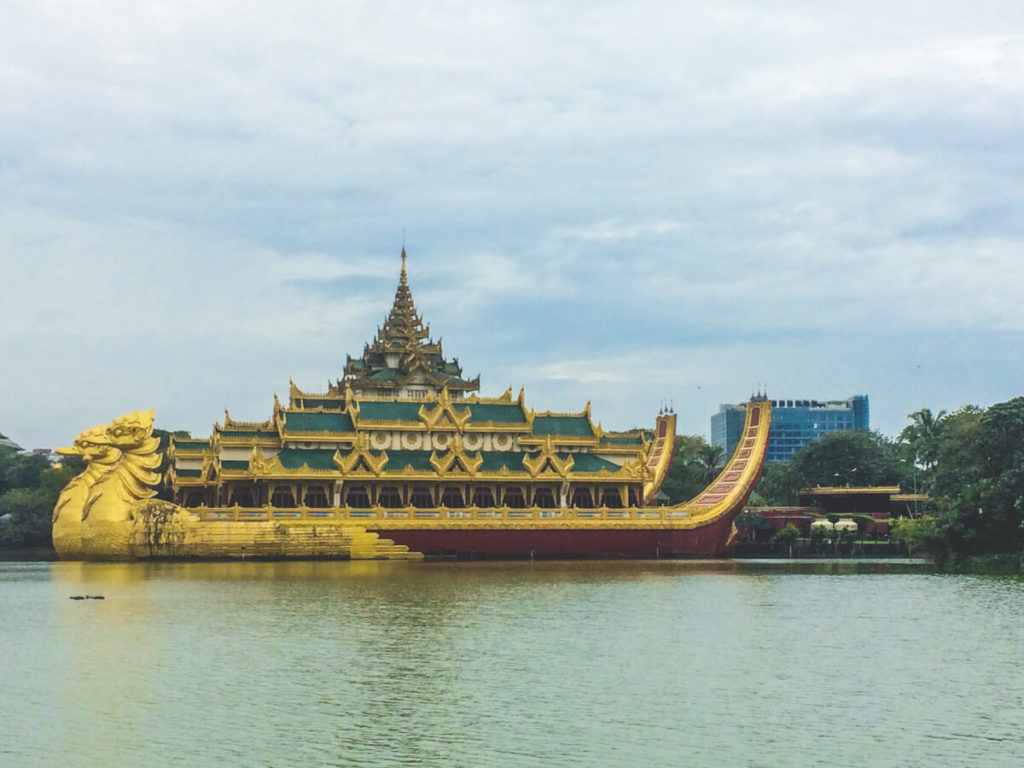
Be sure to take the Circle Train (approx. $0.20). The train circles Yangon in three hours. The highlight is not only the journey through the suburbs, but also the way the locals transport their goods—especially fruit and vegetables—and sell them on the train. The journey covers 46 kilometers and 39 stations, and everyone rides: farmers, tourists, monks, vendors.
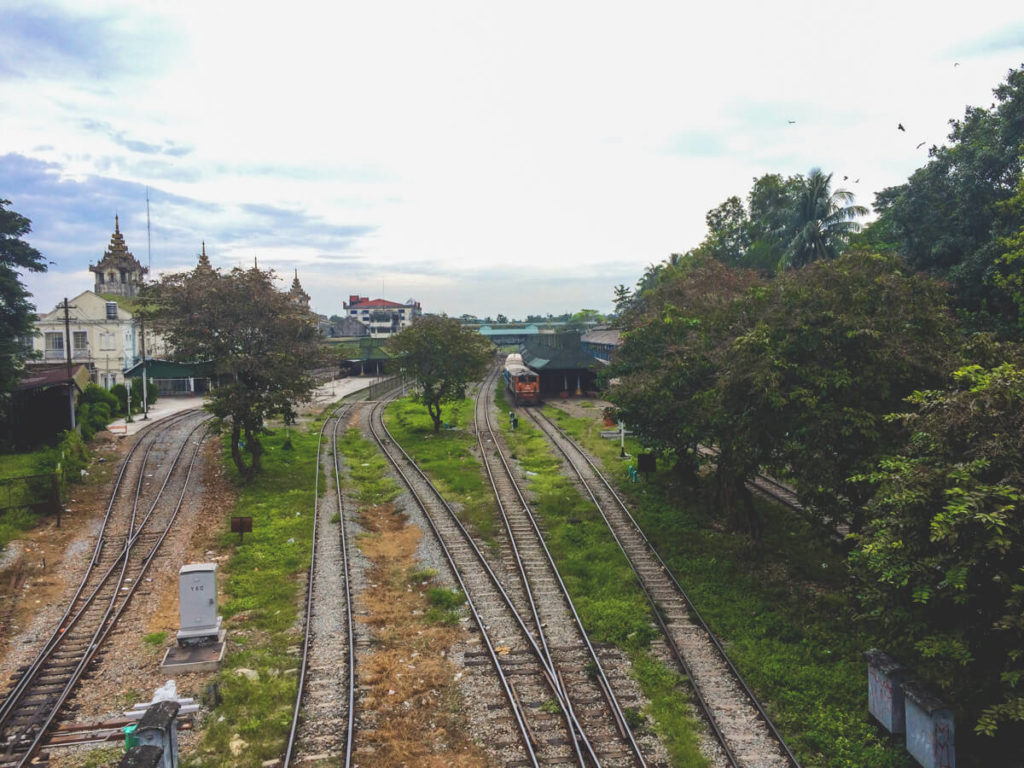
Stop 2: Inle Lake
My journey continued toward Inle Lake. I took the night bus (blankets and entertainment provided!) from Yangon to a crossroads 10 km from Nyaung Shwe. There, the pickup truck was waiting for the five tourists who wanted to continue on to Nyaung Shwe. The government charges a $10 entrance fee to visit the region. The pickup stops at a small ticket booth on the road between Nyaung Shwe and Khaung Daing. I spent two nights in a dorm at the Bright Hotel* (€14).
Sights and Highlights at Inle Lake
On my first day in this region, I went on a bike tour using a bike rented from the accommodation (approx. $1). I also visited the temple in Khaung Daing. From Khaung Daing, you can take a boat to the east side of the lake. The way back then leads past the Red Mountain Estate Vineyards & Winery. The steep climb to the winery is rewarded with a great view over the lake, and the food is also impressive.
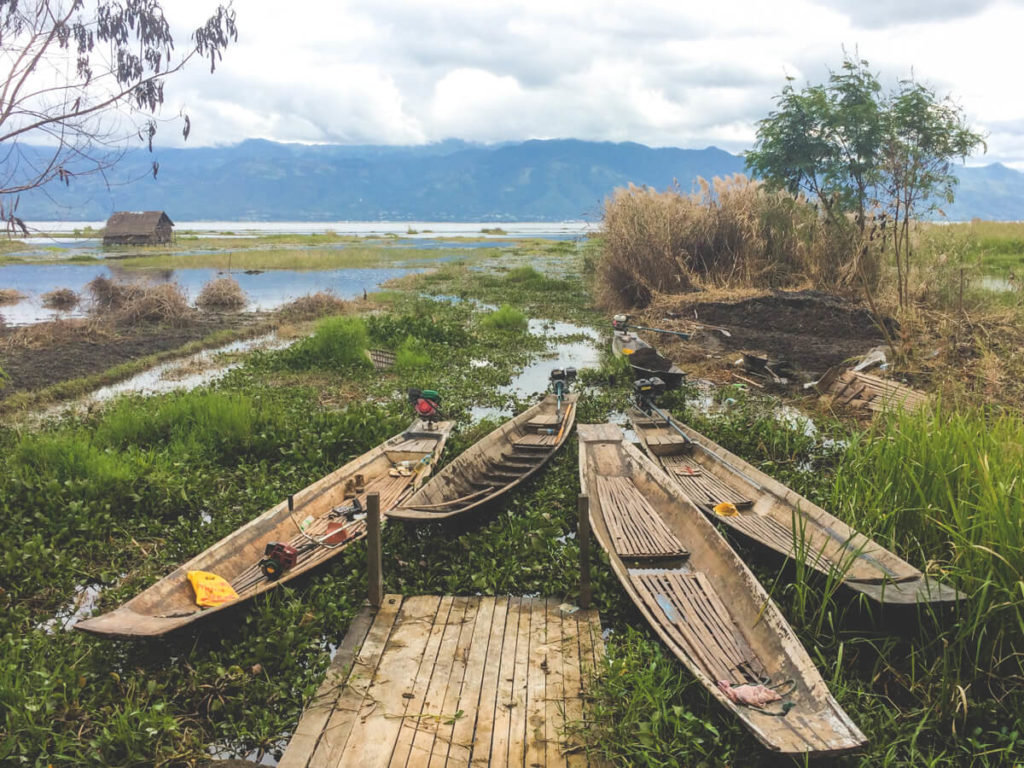
On the second day, a day trip to Inle Lake was on the agenda. The tour can be booked at your accommodation or directly in town. You rent the entire boat for about 7 hours, and the price is approximately $24. I shared the price with two Brits I met the day before on my bike tour.
The boat trip will visit the following sights: Nga-Phe-Kyaung (Jumping Cat Monastery), Floating Gardens (floating markets), various floating villages, lunch at one of the floating villages, and a detour to see the one-legged rowers. Photos of the latter are unfortunately staged; after the photo, the fisherman will ask for a donation.
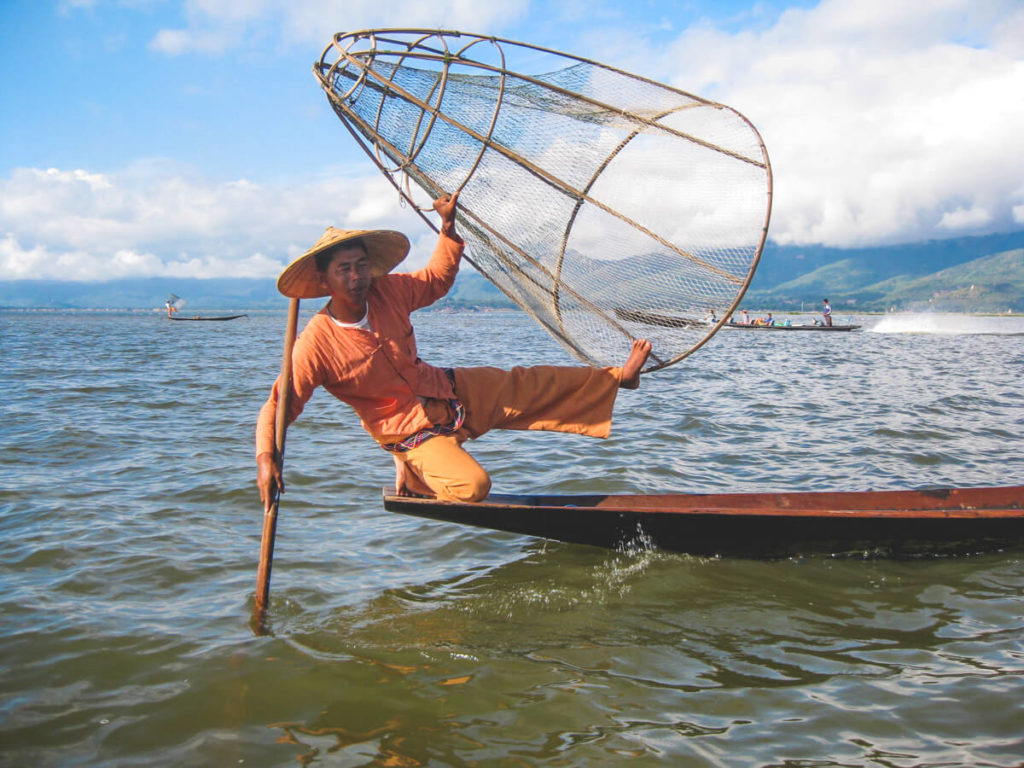
At The French Touch Café, the film “Inthar,” directed by owner Yannick, is shown every evening at 7:30 p.m. The film tells the story of a young monk from the region. Address: Kyaung Taw Shayt Street (the café is easily recognizable by its orange seat cushions).
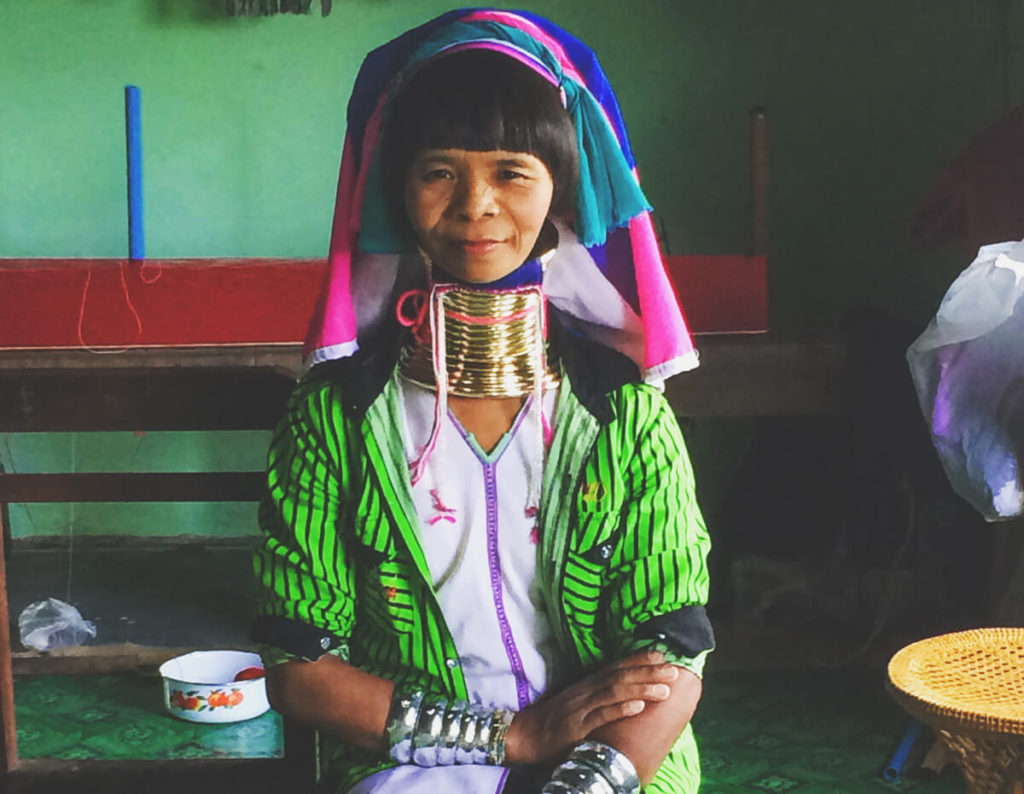
Stop 3: Mandalay
I spent the next two nights in the city of Mandalay, which I reached by night bus from Nyaung Shwe (right in town). From there, I took a motorbike taxi to my accommodation, Downtown @ Mandalay*. I paid approximately €23 for the shared room.
Sights and Highlights in Mandalay
On the first day, I rented a motorbike taxi with a driver for the whole day for about $10 and explored the city of Mandalay. I visited Mandalay Hill. This is a 236-meter-high mountain in the north of the city with a fantastic view over Mandalay. I can also recommend the Kothodaw Pagoda (or the largest book in the world; each of the 729 small, white pagodas contains a marble tablet with text) and the Royal Palace. This is a huge square area measuring 2×2 kilometers in the middle of downtown Mandalay.
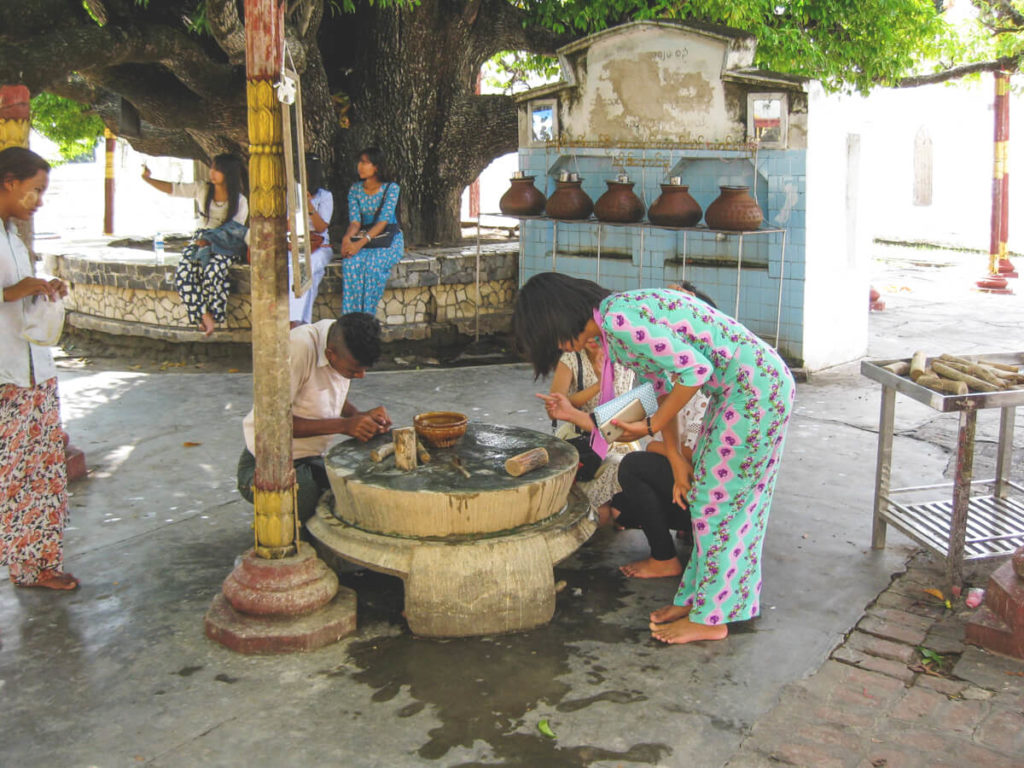
The next day, I booked the same motorbike taxi from the previous day and took a day trip to the surrounding area of Mandalay. During this trip, I visited the city of Inwa. This was the capital of the kingdom for more than 400 years. You can tour the area with a horse-drawn carriage ride for about $6. We also stopped in the royal city of Amarapura. The U Bein Bridge near Amarapura is particularly beautiful; at 1,200 meters long, it is the longest wooden bridge in the world. It’s especially beautiful at sunset, as many locals take an evening stroll there.
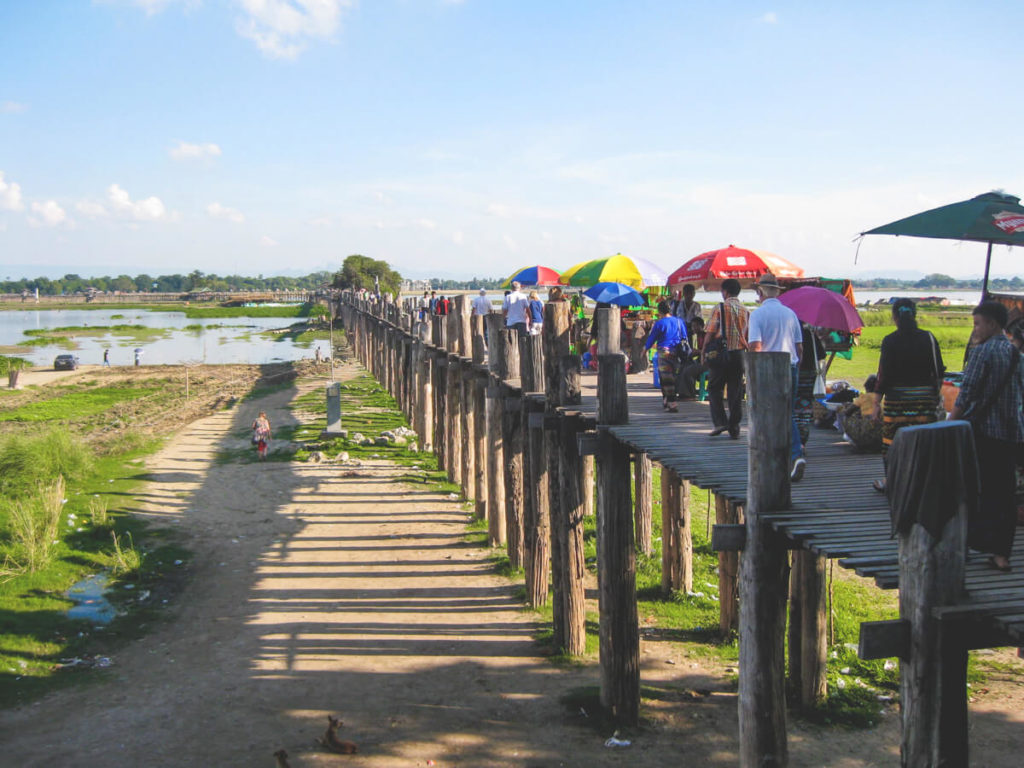
On the third day, I took the ferry from Mandalay (end of 26th Street) to Mingun at 9:00 a.m. Tickets are available directly at the office at the harbor (approximately $3). A visit to Mingun will incur an additional $3 entrance fee. The ferry departs back to Mandalay at 12:30 p.m., but there’s plenty of time to explore, as all three sights in Mingun are within walking distance. These include the Mingun Temple (a gigantic temple was once planned to be built here, but only the impressive base of the temple was actually completed), the world’s largest functioning bell, and the white Mingun Pagoda.
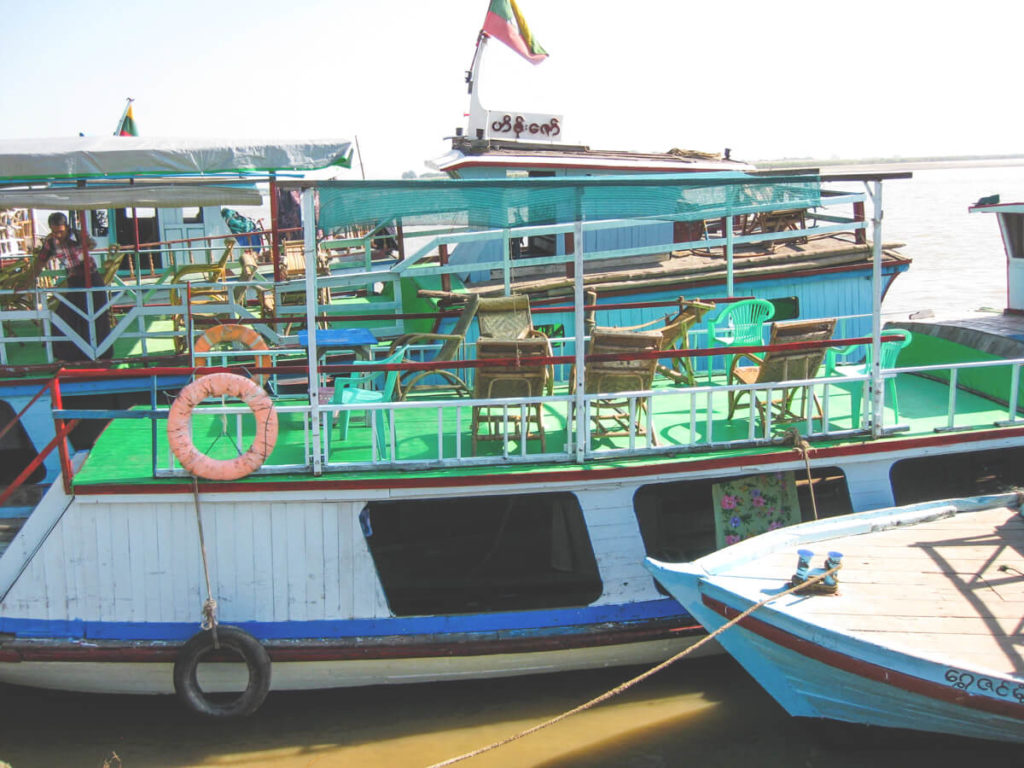
Tip: Many marble workshops are located in the southern districts of Mandalay. Some workers work the marble in front of their shops, creating a fine white marble dust in the air. Simply ask the motorbike taxi driver to stop briefly at one of the workshops and look over the craftsmen’s shoulders.
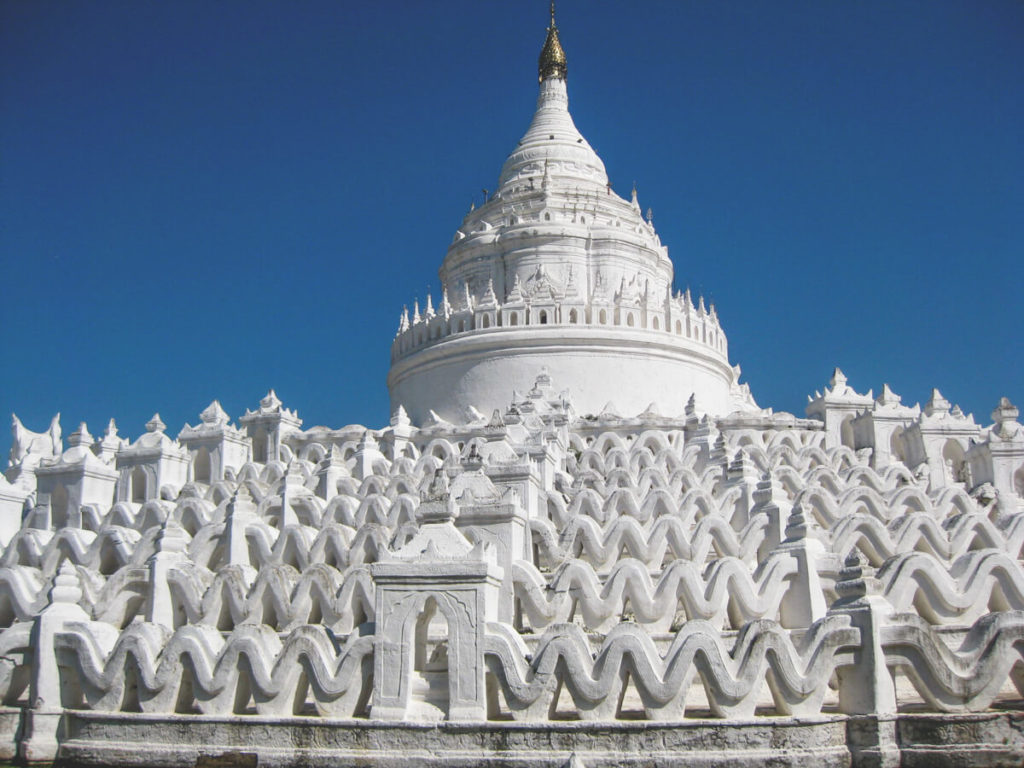
Stop 4: Bagan
From Mandalay, I took the night train to Bagan. I spent the next three nights at the Royal Bagan Hotel*. The hotel cost me about €43. But back to the night train. Unfortunately, it had no windows, so the wind blew around my ears all night. As a result, I caught a cold a few days later. So it’s better to take blankets or sleeping bags with you on the train to snuggle up in. From the train station in Bagan, I took a motorbike taxi to my accommodation.
Sights and Highlights in Bagan
Bagan consists of the three towns of Nyaung U, Old Bagan, and New Bagan. This sounds manageable at first, but the entire area includes approximately 2,000 temples and pagodas. Nyaung U is in the northeast, Old Bagan in the northwest, and New Bagan in the southwest. For a rough idea, here are the distances between the towns:
- Nyaung U – Old Bagan: 7 km
- Old Bagan – New Bagan: 4.5 km
- New Bagan – Nyaung U: 11.5 km
There is a paved road and several unpaved sand tracks between the towns. Bagan is definitely very expansive. Therefore, it makes sense to explore the area by e-scooter or bicycle. I rented an e-scooter every day from my accommodation (about $6), but the nearest rental shop wouldn’t have been far away. E-scooters look like regular motor scooters and ride the same way, but are completely electric and therefore silent.
The e-scooters must always be returned to the rental shop or accommodation in the evening so they can be recharged overnight. Regular motor scooters are prohibited for tourists in Bagan. There’s no need to fear the otherwise chaotic driving behavior on Southeast Asian roads in Bagan; life is normal here, and traffic drives on the right throughout the country.
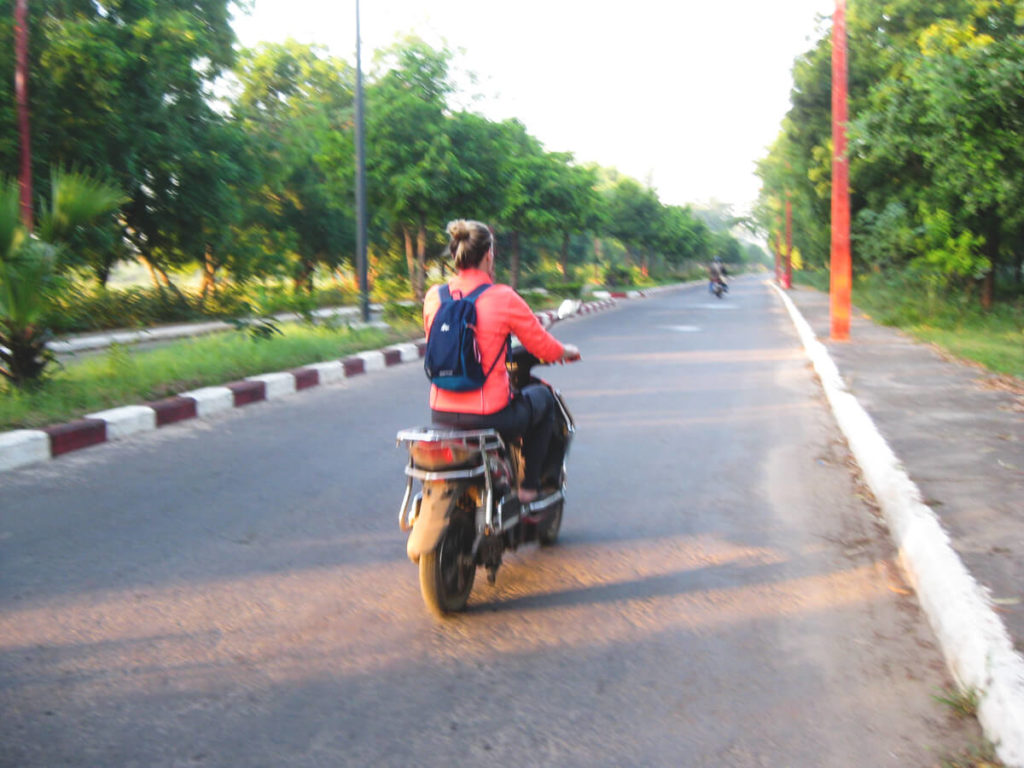
There are so many temples and pagodas in Bagan that it’s not easy to choose. Really beautiful temples and pagodas include: Dhammayazika Temple (interesting shape), Manuha Temple (many Buddha images in a very small space), Thatbinnyu Temple (at 61 meters the tallest building in Bagan), Shwegugyi Temple (climb to the top possible, from there a great view), Bupaya Pagoda (Bupaya means bottle gourd), Ananda Temple, Shwezigon Pagoda (completely covered in gold).

Sunrise and sunset spots in Bagan
At 2,000 When it comes to pagodas and temples, every place has something wonderful to offer. If you ask locals or other tourists about the best spots, you’ll often get recommendations for the following:
- Sunrise and sunset at the Shewsandaw Pagoda (highly recommended, but very crowded).
- Sunrise at the Law Ka Ou Shaung Pagoda (not as crowded as the Shewsandaw Pagoda and only a few hundred meters further)
- Sunset at the Pyathadar Temple (similarly crowded as the Shewsandaw Pagoda)
- Sunrise and sunset at the Bulethi Pagoda (not too crowded yet)
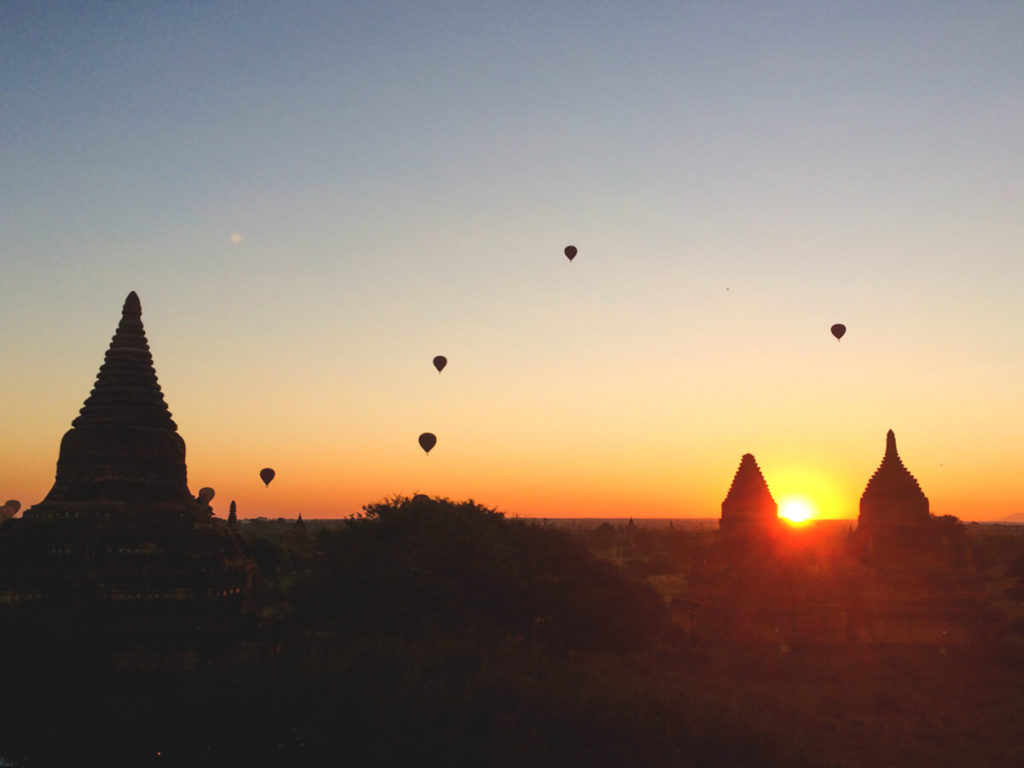
The absolute highlight in the region is a balloon ride over the pagoda field in Bagan. You can either go along yourself or enjoy the ascent of the hot air balloons at sunrise from one of the pagodas. It’s also a wonderful place to take great photos. The hot air balloon ride is certainly a special experience, but also expensive. I can’t judge whether it’s really that great, as I didn’t fly in a hot air balloon.
My decision was based on the fact that I can’t take difficult photos of the colorful balloons above the pagodas while standing in one of the balloons. Operators are: Balloons over Bagan, Oriental Ballooning, and Golden Eagle Ballooning. All operators charge between $350 and $400 per person. The trips are from October to March.
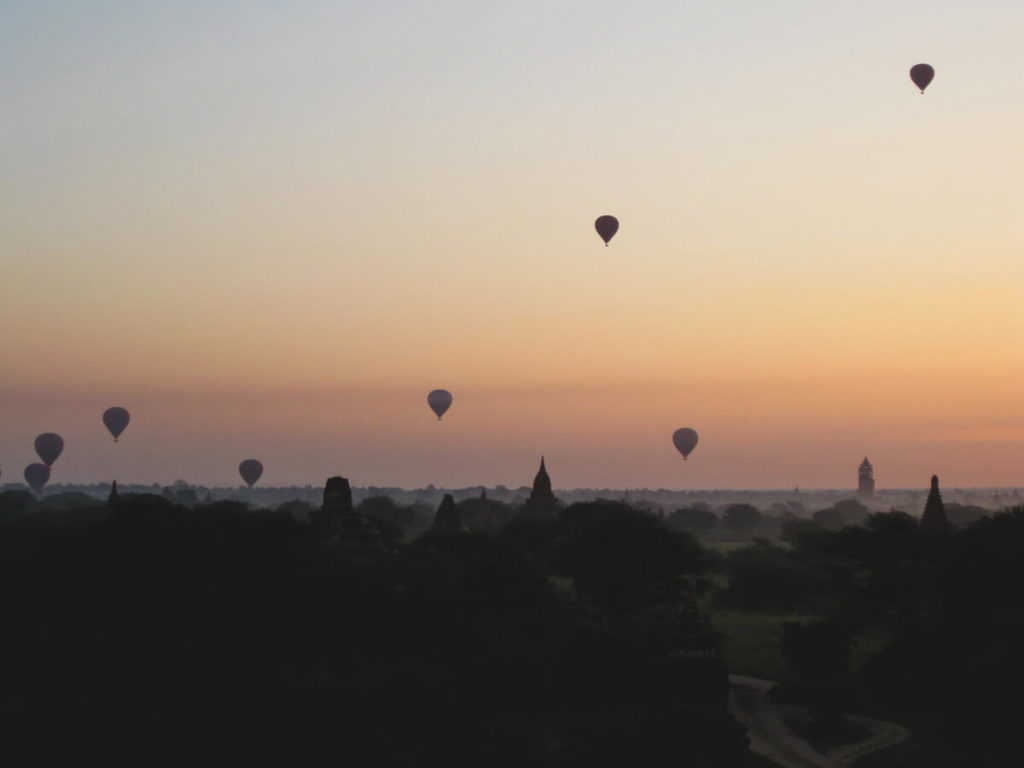
I then took the night bus back to Yangon and spent my last day there before returning to Germany. I ended the day leisurely at the Bogyoke Aung San Market and bought a few souvenirs for my family.
Safety in Myanmar
Yes, I felt absolutely safe at all times. This may be due, on the one hand, to the fact that Myanmar is a Buddhist country. Almost 90% of Burmese people are Buddhists. On the other hand, as a solo traveler, I often have the feeling that everyone is worried about me.
Best example: I’m standing with a 60-liter backpack on a completely overcrowded public bus heading towards the long-distance bus station. Someone in the last row stands up especially for me, and everyone else on the bus makes sure I get to my seat with my luggage.
Otherwise, I use common sense when traveling: I always carry valuables (money, passport, camera) with me, and late at night, I don’t wander around alone, but rather walk with other travelers.
Duration of the Tour
I traveled through Myanmar for two weeks in November/December 2017, and in my opinion, that’s the absolute minimum. Next time, I would travel for three weeks and make a detour to Kalaw, where there are supposed to be particularly good hiking trails.
Costs and Prices
Prices have risen considerably in recent years. An overnight stay in a shared room can easily cost around €10 per night. There’s also an entrance fee for almost every tourist attraction. The prices for food and drink, on the other hand, are barely worth mentioning. At the numerous food stalls, you can get a very good meal for €1. Even a beer costs no more than €0.50 (export beer is, of course, a bit more expensive). Backpackers can easily budget around €20 per day.
Food and Drink
A typical dish is Mohinga (fish soup with thin noodles). Burmese cuisine is heavily influenced by its neighboring countries China, India, and Thailand. Rice and raw vegetables are an important ingredient. Typical drinks include green tea, sugarcane juice, and local beer (Myanmar Beer and Mandalay Beer).
3 Important Things to Pack
Be sure to pack a blanket or sleeping bag for the night train, as they are usually not very comfortable. You should also have a power adapter in your luggage. The official currency is the Myanmar Kyat (MKK). 1,000 MKK is approximately €0.59 or $0.66. US dollars are a welcome means of payment. As a precaution, bring clean, undamaged dollar bills. Sometimes, torn dollar bills are not accepted when paying.
More Information & Tips
Don’t be surprised when you first see men, as they often wear the men’s “Longhi” skirt. Wearing shorts underneath, they do it like the Scots. Women and children rub their faces with thanaka, a yellow-white paste made from tree bark. Thanaka protects against UV rays and has a cleansing effect—feel free to try it. And one more thing: “Mingalaba” means “May blessings be upon you.” That’s how you’re greeted in Myanmar.
